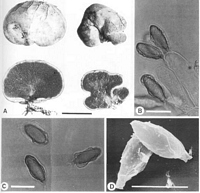|
 Hysterangium rupticutis Hysterangium rupticutis
SynonymsHysterangium sp. 2
BiostatusPresent in region - Exotic
Images (click to enlarge)
Caption: Fig. 7 Hysterangium rupticutis. A, Basidiomata exterior and in section (PDD 48322). B,
Basidium and spores by bright field (PDD 48322). C, Basidiospores by bright field (PDD
48322). D, Basidiospores by SEM (PDD 48322). Scale: 1 cm (A), 10 µm (B |
Article: Castellano, M.A.; Beever, R.E. (1994). Truffle-like Basidiomycotina of New Zealand: Gallacea, Hysterangium, Phallobata, and Protubera. New Zealand Journal of Botany 32(3): 305-328 (http://www.rsnz.org/publish/abstracts.php).
Description: Basidiomata up to 2.5 cm diam., depressed globose to irregularly shaped, dingy white
when fresh, bruising µmk, grey where exposed, glabrous, exposed portion cracked into
irregular plates. Gleba dark greenish grey when fresh, dark olive when dried; locules
more or less radially arranged, sometimes lamellate, usually elongate, partially filled.
Rhizomorph single, stout, c. 1 mm diam., soon branched, concolorous with peridium.
Columella dendroid, gelatinous, white, not well developed, sometimes inconspicuous.
Taste not noted. Odour perfumed to musty. Peridium not separable from gleba,
2-layered, 500-600 µm thick; epicutis 400-450 µm thick, of hyaline, thin-walled,
irregularly shaped, inflated cells up to 50 µm diam., cells becoming gradually smaller
and pale brown near subcutis, clamp connections absent, epicutis overlain with a thin (<
10 µm), loosely interwoven layer of crystal-encrusted hyphae 2-3 µm diam.; subcutis 40-50 µm thick, of hyaline,
thin-walled, somewhat agglutinated, compactly interwoven,
irregularly shaped hyphae 2-3(-7.5) µm diam., clamp connections absent. Trama 70-100
µm thick, of hyaline, thin-walled, compactly interwoven hyphae, 2-3 µm diam., in a
gelatinised matrix, clamp connections absent. Basidia hyaline, elongate with a
constricted base, somewhat swollen centrally, 40-55 x 6-8 µm, 4-spored, clamp
connections common. Spores minutely verrucose, 14-16 x 5-6 µm, ellipsoid to broadly
ellipsoid, apex acute to occasionally subpapillate, base with a slight sterigmal
attachment; wall c. 1 µm thick. Utricle distinct, wrinkled, more or less adhering to spore
wall, occasionally inflated to 1 µm. Spore colour in KOH hyaline singly, pale olive in
mass.
Habitat: Habitat: hypogeous to subepigeous in modified communities, putatively mycorrhizal
with Eucalyptus spp. including E. fastigiata. Season: July.
Distribution: New Zealand.
Notes: ETYMOLOGY: From Latin ruptus, ruptured, and cubs, skin, referring to the cracked
peridium of exposed specimens.
REMARKS: Known only from New Zealand, but the host association suggests that the
species has been introduced from Australia. Chu-Chou & Grace (1983) illustrate this
species as "Hysterangium sp 2".
Article: Gadgil, P.D. (in association with Dick, M.A.; Hood, I.A.; Pennycook, S.R.) (2005). Fungi on trees and shrubs in New Zealand. Fungi of New Zealand. Ngā Harore o Aotearoa 4: xi + 437 p. Hong Kong: Fungal Diversity Press.
Description: Type: Mycorrhizal Fungi; Description: Basidiomata hypogeous to subepigeous, depressed globose to irregularly shaped, dirty white, pink when bruised, surface cracked when exposed, up to 25 mm in diameter, with a single, stout rhizomorph; peridium composed of two layers, pale brown in section. Gleba greenish grey to dark olive; locules elongate, more or less radially arranged, partially filled with basidiospores; tramal plates composed of hyaline interwoven hyphae; columella not well developed, branched. Basidiospores broadly elliptical, 0-septate, 14–16 × 5–6 μm, verrucose, hyaline; utricle distinct, wrinkled, more or less adhering to the spore wall.
Distribution: Distribution: Auckland, Bay of Plenty.
|